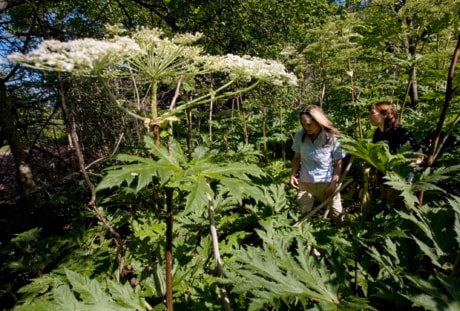TORONTO — When David Rawnsley found the distinctive bright yellow flowers of wild parsnip growing on his property, he knew he had to take action.
So on one hot, sunny day, Rawnsley — who lives in Williamstown, Ont., about an hour southeast of Ottawa — got to work, ripping out the unwanted invader.
Bad idea.
“I came up in blotches everywhere — all down my legs, all along my body, some on my face,” he says.
For a good number of gardeners, campers and nature lovers, Rawnsley’s story will bring back memories of their own encounters with one or more of Canada’s unfriendly poisonous plants.
But health officials say taking quick action, combined with a good dose of common sense, can help nip those annoying, painful rashes in the bud.
“We see people who come into contact with poison ivy, primarily,” says Dr. Cheryl Rosen, head of Toronto Western Hospital’s dermatology division.
The irritant in poison ivy and its relatives, poison oak and poison sumac, is called urushiol, a potent allergen that can lead to nasty skin rashes.
Because urushiol is an allergen, a person exposed to poison ivy for the first time might take up to three weeks to develop a rash as the body figures out what it’s been attacked by, says Rosen.
Subsequent exposures lead to rashes much more quickly, she adds.
Luckily, urushiol can be washed off within 60 minutes after exposure, limiting the rash, says Rosen.
If a rash does develop, cold wet compresses will help dry out blisters, she says, and prescription steroids, both topical and oral, can reduce the rash’s severity.
It’s a myth that just the leaves of the poison ivy are poisonous, says Rosen.
Touching any part of the plant can cause rashes and blisters, she says.
There’s also the misconception that the rash grows because the blisters burst and spread the toxins along the skin — not true, Rosen points out.
“It’s not actually spreading because of the fluid in the blisters. It’s because different parts of the body are reacting at different times to the same exposure,” she says.
One bright spot is that poison ivy — with its cluster of three leaves, each with a serrated edge — doesn’t look like a lot of other plants.
That means people who are properly informed can avoid it in the first place, says John Thor Arnason, a biology professor and the head of the University of Ottawa’s medicinal plant laboratory.
“Go Google it ... learn what it looks like,” Arnason says.
“Know that it’s going to be in sunny, warm areas like stream banks, (by) trunks of trees, the edges of campgrounds, and so on.”
Pets can also spread the poison ivy’s resin by carrying it on their fur, so keep that in mind if your dog goes off romping through the bushes, Arnason says.
As for wild parsnip, which flourishes along rural roadsides and in abandoned fields, its sap contains furocoumarins, chemical compounds that make the skin hypersensitive to sunlight.
Those who expose themselves to plants containing furocoumarins, like wild parsnip and giant hogweed, risk severe blisters and rashes if they stay in the sun.
“It’s like getting a bad sunburn,” says Rod Krick, a natural heritage ecologist with the Credit Valley Conservation Authority, which has been battling an outbreak of giant hogweed this year in the Brampton, Ont., area, northwest of Toronto.
Anyone who encounters such plants should make sure to keep the exposed area of their skin out of UV light, says Krick. Like urushiol, furocoumarins can also be washed off with dish soap if this is done quickly after initial exposure, he says.
It’s also important, says Krick, that people don’t buy and plant the “very attractive” giant hogweed — which was originally grown in China and transplanted to England as an ornamental plant — from greenhouses and nurseries, given that it’s not native to North America.
“It’s been here for awhile, but it’s not at the point where it’s out of control and we can’t do anything about it,” says Krick.
Of course, there are also plants and berries that are toxic when eaten. The Ontario Poison Centre lists more than 70 plants that should not be the choice for a nature-walk nibble, and warns people not to make tea from wild leaves or flowers or to assume that something’s edible just because birds or wildlife eat it.
Nor should people who don’t know what they’re doing eat wild mushrooms, says Arnason.
The most poisonous mushrooms contain a toxin called amanitin, which stops cells from synthesizing proteins and can lead to a “very slow, excruciating death” over the span of a week or two, says Arnason.
While the flamboyant amanita mushrooms, with their bright colours and broad caps, contain a number of edible species, they also account for about 95 per cent of all mushroom-related deaths.
“The only way to collect and eat mushrooms is you must be a real expert on them, and be able to identify them correctly and properly,” says Arnason.
